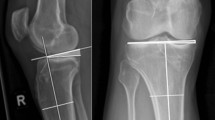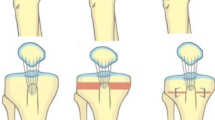Abstract
Purpose
Revision ACL reconstruction requires careful analysis of failure causes particularly in cases of two previous graft ruptures. Intrinsic factors as excessive tibial slope or narrow femoral notch increase failure risks but are rarely addressed in revision surgery. The authors report outcomes, at minimum follow-up of 2 years, for second revision ACL reconstructions combined with tibial deflexion osteotomy for correction of excessive slope (>12°).
Methods
Nine patients that underwent second revision ACL reconstruction combined with tibial deflexion osteotomy were retrospectively studied. The mean age was 30.3 ± 4.4 years (median 28; range 26–37), and mean follow-up was 4.0 ± 2.0 years (median 3.6; range 2.0–7.6). Autografts were harvested from the quadriceps tendon (n = 8) or hamstrings (n = 1), and tibial osteotomy was done by anterior closing wedge, without detachment of the patellar tendon, to obtain a slope of 3° to 5°.
Results
All patients had fused osteotomies, stable knees, and there were no intraoperative or postoperative complications. The mean posterior tibial slope decreased from 13.2° ± 2.6° (median 13°; range 12°–18°) preoperatively to 4.4° ± 2.3° (median 4°; range 2°–8°) postoperatively. The mean Lysholm score was 73.8 ± 5.8 (median 74; range 65–82), and the IKDC-SKF was 71.6 ± 6.1 (median 72.8; range 62.2–78.5).
Conclusion
The satisfactory results of second revision ACL reconstruction combined with tibial deflexion osteotomy at minimum follow-up of 2 years suggest that tibia slope correction protects reconstructed ACL from fatigue failure in this study. The authors stress the importance of careful analysis failure causes prior to revision ACL reconstruction, and recommend correction of tibial slope if it exceeds 12°, to reduce the risks of graft retear.
Level of evidence
III.


Similar content being viewed by others
References
Anderson AF, Dome DC, Gautam S, Awh MH, Rennirt GW (2001) Correlation of anthropometric measurements, strength, anterior cruciate ligament size, and intercondylar notch characteristics to sex differences in anterior cruciate ligament tear rates. Am J Sports Med 29(1):58–66
Bien DP (2011) Rationale and implementation of anterior cruciate ligament injury prevention warm-up programs in female athletes. J Strength Cond Res 25(1):271–285
Boden BP, Breit I, Sheehan FT (2009) Tibiofemoral alignment: contributing factors to noncontact anterior cruciate ligament injury. J Bone Joint Surg Am 91(10):2381–2389
Bonin N, Ait Si Selmi T, Donell ST, Dejour H, Neyret P (2004) Anterior cruciate reconstruction combined with valgus upper tibial osteotomy: 12 years follow-up. Knee 11(6):431–437
Brandon ML, Haynes PT, Bonamo JR, Flynn MI, Barrett GR, Sherman MF (2006) The association between posterior-inferior tibial slope and anterior cruciate ligament insufficiency. Arthroscopy 22(8):894–899
Colombet P (2011) Knee laxity control in revision anterior cruciate ligament reconstruction versus anterior cruciate ligament reconstruction and lateral tenodesis: clinical assessment using computer-assisted navigation. Am J Sports Med 39(6):1248–1254
Dejour D, Khun A, Dejour H (1998) Osteotomie tibiale de déflexion et laxité chronique antérieure à propos de 22 cas. Rev Chir Orthop, 28–29
Dejour D, Vanconcelos W, Bonin N, Saggin PR (2013) Comparative study between mono-bundle bone-patellar tendon-bone, double-bundle hamstring and mono-bundle bone-patellar tendon-bone combined with a modified Lemaire extra-articular procedure in anterior cruciate ligament reconstruction. Int Orthop 37(2):193–199
Dejour H, Bonnin M (1994) Tibial translation after anterior cruciate ligament rupture. Two radiological tests compared. J Bone Joint Surg Br 76(5):745–749
Ebben WP, Fauth ML, Petushek EJ, Garceau LR, Hsu BE, Lutsch BN, Feldmann CR (2010) Gender-based analysis of hamstring and quadriceps muscle activation during jump landings and cutting. J Strength Cond Res 24(2):408–415
MARS Group (2014) Effect of graft choice on the outcome of revision anterior cruciate ligament reconstruction in the Multicenter ACL Revision Study (MARS) Cohort. Am J Sports Med 42(10):2301–2310
Feucht MJ, Mauro CS, Brucker PU, Imhoff AB, Hinterwimmer S (2013) The role of the tibial slope in sustaining and treating anterior cruciate ligament injuries. Knee Surg Sports Traumatol Arthrosc 21(1):134–145
Gifstad T, Drogset JO, Viset A, Grontvedt T, Hortemo GS (2013) Inferior results after revision ACL reconstructions: a comparison with primary ACL reconstructions. Knee Surg Sports Traumatol Arthrosc 21(9):2011–2018
Hohmann E, Bryant A, Reaburn P, Tetsworth K (2011) Is there a correlation between posterior tibial slope and non-contact anterior cruciate ligament injuries? Knee Surg Sports Traumatol Arthrosc 19(Suppl 1):S109–S114
Kamath GV, Redfern JC, Greis PE, Burks RT (2011) Revision anterior cruciate ligament reconstruction. Am J Sports Med 39(1):199–217
Lazar TP, Berry CR, deHaan JJ, Peck JN, Correa M (2005) Long-term radiographic comparison of tibial plateau leveling osteotomy versus extracapsular stabilization for cranial cruciate ligament rupture in the dog. Vet Surg 34(2):133–141
Li Y, Hong L, Feng H, Wang Q, Zhang J, Song G, Chen X, Zhuo H (2014) Posterior tibial slope influences static anterior tibial translation in anterior cruciate ligament reconstruction: a minimum 2-year follow-up study. Am J Sports Med 42(4):927–933
Lind M, Lund B, Fauno P, Said S, Miller LL, Christiansen SE (2012) Medium to long-term follow-up after ACL revision. Knee Surg Sports Traumatol Arthrosc 20(1):166–172
Lustig S, Scholes CJ, Leo SP, Coolican M, Parker DA (2013) Influence of soft tissues on the proximal bony tibial slope measured with two-dimensional MRI. Knee Surg Sports Traumatol Arthrosc 21(2):372–379
Magnussen RA, Dahm DL, Neyret P (2014) Osteotomy for slope correction following failed ACL reconstruction. In: Marx RG (ed) Revision ACL reconstruction: indications and technique. Springer, New York, pp 221–226. doi:10.1007/978-1-4614-0766-9
Mandelbaum BR, Silvers HJ, Watanabe DS, Knarr JF, Thomas SD, Griffin LY, Kirkendall DT, Garrett W Jr (2005) Effectiveness of a neuromuscular and proprioceptive training program in preventing anterior cruciate ligament injuries in female athletes: 2-year follow-up. Am J Sports Med 33(7):1003–1010
Marti CB, Gautier E, Wachtl SW, Jakob RP (2004) Accuracy of frontal and sagittal plane correction in open-wedge high tibial osteotomy. Arthroscopy 20(4):366–372
Moeller EM, Cross AR, Rapoff AJ (2006) Change in tibial plateau angle after tibial plateau leveling osteotomy in dogs. Vet Surg 35(5):460–464
Morgan JA, Dahm D, Levy B, Stuart MJ, Group MS (2012) Femoral tunnel malposition in ACL revision reconstruction. J Knee Surg 25(5):361–368
Myer GD, Ford KR, Khoury J, Succop P, Hewett TE (2011) Biomechanics laboratory-based prediction algorithm to identify female athletes with high knee loads that increase risk of ACL injury. Br J Sports Med 45(4):245–252
Neyret P, Zuppi G, Selmi TAS (2000) Tibial deflexion osteotomy. Oper Tech Sports Med 8(1):61–66
Senisik S, Ozgurbuz C, Ergun M, Yuksel O, Taskiran E, Islegen C, Ertat A (2011) Posterior tibial slope as a risk factor for anterior cruciate ligament rupture in soccer players. J Sports Sci Med 10(4):763–767
September AV, Schwellnus MP, Collins M (2007) Tendon and ligament injuries: the genetic component. Br J Sports Med 41(4):241–246
Slocum B, Slocum TD (1993) Tibial plateau leveling osteotomy for repair of cranial cruciate ligament rupture in the canine. Vet Clin N Am Small Anim Pract 23(4):777–795
Sonnery-Cottet B, Archbold P, Cucurulo T, Fayard JM, Bortolletto J, Thaunat M, Prost T, Chambat P (2011) The influence of the tibial slope and the size of the intercondylar notch on rupture of the anterior cruciate ligament. J Bone Joint Surg Br 93(11):1475–1478
Sonnery-Cottet B, Mogos S, Thaunat M, Archbold P, Fayard JM, Freychet B, Clechet J, Chambat P (2014) Proximal tibial anterior closing wedge osteotomy in repeat revision of anterior cruciate ligament reconstruction. Am J Sports Med 42(8):1873–1880
Thomas NP, Kankate R, Wandless F, Pandit H (2005) Revision anterior cruciate ligament reconstruction using a 2-stage technique with bone grafting of the tibial tunnel. Am J Sports Med 33(11):1701–1709
Tillman MD, Smith KR, Bauer JA, Cauraugh JH, Falsetti AB, Pattishall JL (2002) Differences in three intercondylar notch geometry indices between males and females: a cadaver study. Knee 9(1):41–46
Todd MS, Lalliss S, Garcia E, DeBerardino TM, Cameron KL (2010) The relationship between posterior tibial slope and anterior cruciate ligament injuries. Am J Sports Med 38(1):63–67
Trojani C, Beaufils P, Burdin G, Bussiere C, Chassaing V, Djian P, Dubrana F, Ehkirch FP, Franceschi JP, Hulet C, Jouve F, Potel JF, Sbihi A, Neyret P, Colombet P (2012) Revision ACL reconstruction: influence of a lateral tenodesis. Knee Surg Sports Traumatol Arthrosc 20(8):1565–1570
Trojani C, Sbihi A, Djian P, Potel JF, Hulet C, Jouve F, Bussiere C, Ehkirch FP, Burdin G, Dubrana F, Beaufils P, Franceschi JP, Chassaing V, Colombet P, Neyret P (2011) Causes for failure of ACL reconstruction and influence of meniscectomies after revision. Knee Surg Sports Traumatol Arthrosc 19(2):196–201
Wright RW, Gill CS, Chen L, Brophy RH, Matava MJ, Smith MV, Mall NA (2012) Outcome of revision anterior cruciate ligament reconstruction: a systematic review. J Bone Joint Surg Am 94(6):531–536
Zaffagnini S, Bonanzinga T, Grassi A, Marcheggiani Muccioli GM, Musiani C, Raggi F, Iacono F, Vaccari V, Marcacci M (2013) Combined ACL reconstruction and closing-wedge HTO for varus angulated ACL-deficient knees. Knee Surg Sports Traumatol Arthrosc 21(4):934–941
Zeng C, Yang T, Wu S, Gao SG, Li H, Deng ZH, Zhang Y, Lei GH (2014) Is posterior tibial slope associated with noncontact anterior cruciate ligament injury? Knee Surg Sports Traumatol Arthrosc. doi:10.1007/s00167-014-3382-x
Author information
Authors and Affiliations
Corresponding author
Ethics declarations
Conflict of interest
None of the authors have conflicts of interest or commercial relations in regard to this study.
Rights and permissions
About this article
Cite this article
Dejour, D., Saffarini, M., Demey, G. et al. Tibial slope correction combined with second revision ACL produces good knee stability and prevents graft rupture. Knee Surg Sports Traumatol Arthrosc 23, 2846–2852 (2015). https://doi.org/10.1007/s00167-015-3758-6
Received:
Accepted:
Published:
Issue Date:
DOI: https://doi.org/10.1007/s00167-015-3758-6




